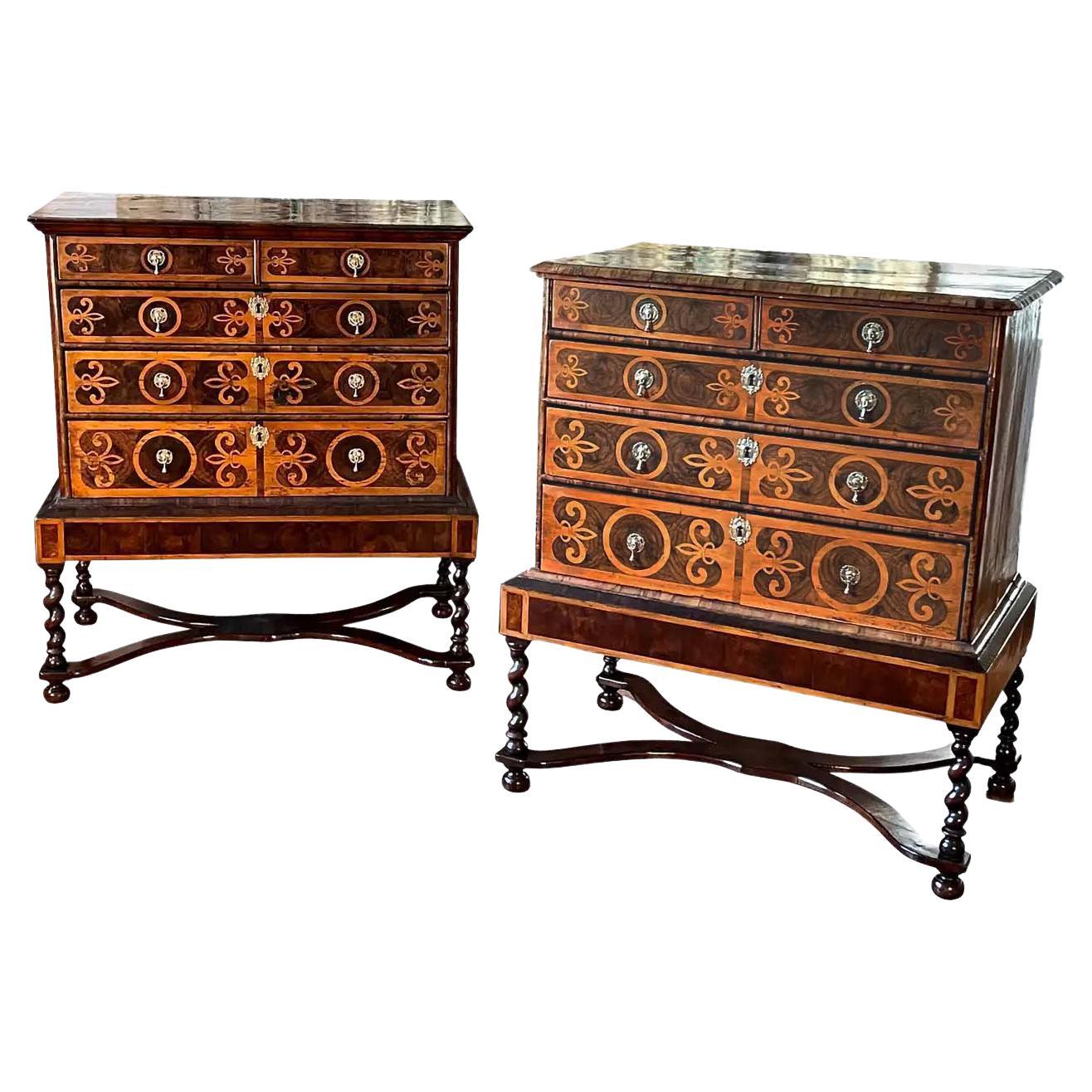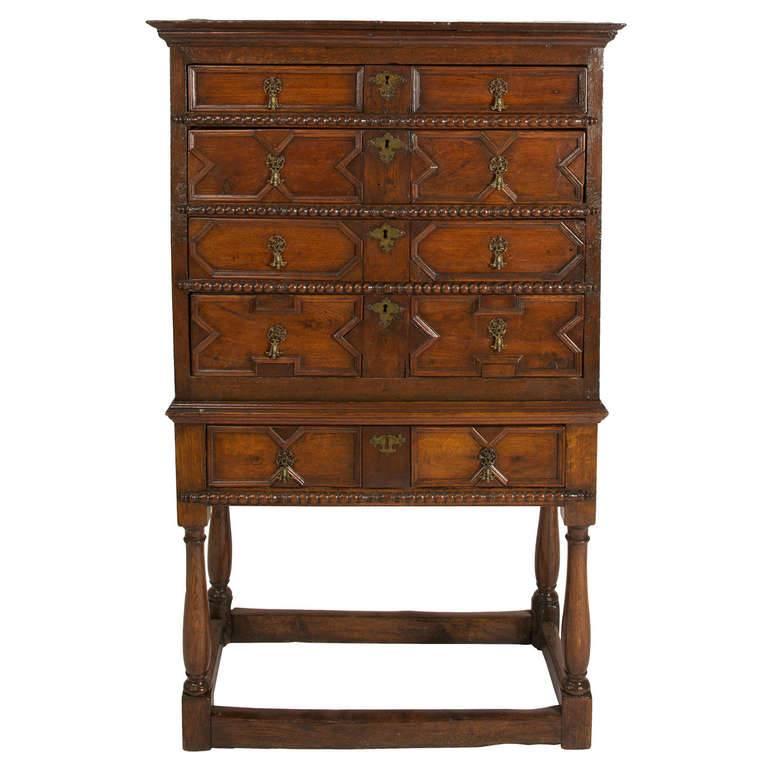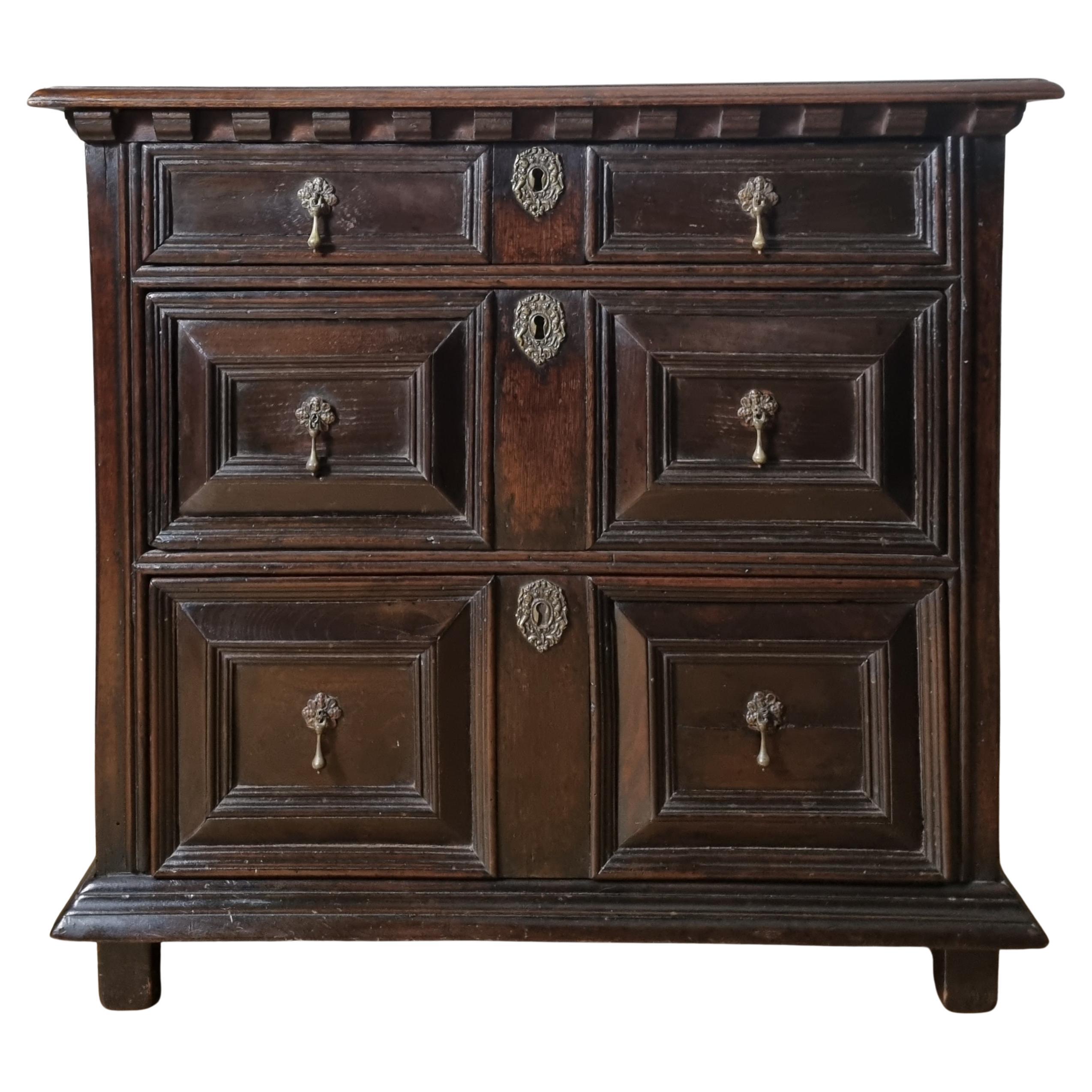Items Similar to Charles II Walnut, Mulberry Marquetry Cabinet, Gilt Stand, 17th C H.F. du Pont
Want more images or videos?
Request additional images or videos from the seller
1 of 10
Charles II Walnut, Mulberry Marquetry Cabinet, Gilt Stand, 17th C H.F. du Pont
About the Item
Charles II walnut and mulberry marquetry cabinet on giltwood stand, c. 1650-1670. Giltwood cresting and stand appear to be from a few decades later.
The form of furniture now described as a cabinet developed across Spain and France in the 16th Century. In architecture, a cabinet is a small private room for the housing or display of precious objects, hence the term could be aptly applied to the small, portable pieces of furniture made for the carriage and display of valuable items and able to stand upon a table, trestle stand or chest. Although known in England from Tudor times, cabinets were not widely produced there until after the Restoration of the monarchy in a1660 - cabinets became extremely popular from this period. This cabinet dates from 1660-1670. These cabinets were larger, perhaps up to six foot tall and 3-4 foot wide, some stood on chests while others were mounted on their own stand; the decoration of the stand matching that of the cabinet and of equal quality, reflecting the treasures stored within.
The revolution in the art of veneering also originally came from the Netherlands and increased in popularity with the return of Charles II from The Hague in 1660. Accompanying the king to England were foreign craftsmen, artists, silversmiths, and designers. In 1660, highly trained craftsmen were sent to northern Italy and southern Germany from the Netherlands to teach apprentices new skills in carpentry, joinery and marquetry.
When William of Orange succeeded to the English throne in 1689, the two countries became even more closely connected.
The Dutch had a vast trade with the East and introduced novel materials such as cane and lacquer. Besides panels of lacquer, complete chests called 'lacred tronks' were imported and placed upon custom-made, highly elaborate, occidental stands of gilt, or silvered, finish. Also, sophisticated methods of construction were required to display the increasingly popular Chinese and Japanese porcelains.
This cabinet has a distinguished and documented provenance. It was acquired by Henry Francis du Pont (1880-1969) quite early in his collecting career and would live with him for almost his entire adult life — both at his Park Ave Manhattan apartment and, later, his Winturthur private residence. H.F. Du Pont was an American horticulturist, an expert and collector of European and early American furniture and decorative arts, and member of the prominent du Pont family. In 1951 he established his estate of Winterthur in Delaware as what has been recognized as the premier museum of American Decorative Arts. A passionate collector with virtually unlimited resources, he assembled the more than 89,000 antiques that fill the museum's 175 rooms and framed the mansion with magnificent plantings, including a Quarry Garden, a Sundial Garden, a Pinetum, and an "Enchanted Woods" for children.
Dimensions
43.0" W x 88.0" H x 21.0" D
- measured assembled (the cresting, cabinet, and stand can be separated).
Provenance:
Private collection of H.F. du Pont, New York.
Private collection of H.F. du Pont, Winturthur.
October 1994, Christie’s New York, Fine English and French Furniture of H.F. du Pont from Winterthur (Lot 30).
Literature:
Sweeney, John, The H.F. du Pont House: A Transition, Fine English and French Furniture and Objects of Art from the Private Residence of Henry Francis du Pont at Winterthur, (New York, NY: Christie’s, 1994).
Emily Elizabeth Martin, Emily Elizabeth. “The Mansion House by the Bridge: An Account of the Henry Francis du Pont Cottage at Winterthur.” Graduate School of Clemson University; The Graduate School of College of Charleston, 2009.
- Dimensions:Height: 88 in (223.52 cm)Width: 43 in (109.22 cm)Depth: 21 in (53.34 cm)
- Style:Charles II (Of the Period)
- Materials and Techniques:
- Place of Origin:
- Period:Mid-17th Century
- Date of Manufacture:1650-1675
- Condition:Repaired: Scattered veneer repair and other reinforcements possible. Additions or alterations made to the original: the giltwood cresting and stand appear to be a few decades later. Wear consistent with age and use. Minor losses. Minor fading. Good antique condition, various scratches, marks, cracks, etc consistent with age and use; variable finish wear/losses; scattered veneer distress and light repairs; other light reinforcements possible; missing one drawer handle. Includes keys.
- Seller Location:Brooklyn, NY
- Reference Number:1stDibs: LU4190323025402
About the Seller
5.0
Platinum Seller
These expertly vetted sellers are 1stDibs' most experienced sellers and are rated highest by our customers.
Established in 2017
1stDibs seller since 2018
590 sales on 1stDibs
Typical response time: 1 hour
- ShippingRetrieving quote...Ships From: Brooklyn, NY
- Return PolicyA return for this item may be initiated within 1 day of delivery.
More From This SellerView All
- Simon Russell for Kartell 8 Drawer Stacking File Cabinet, 1970sBy KartellLocated in Brooklyn, NYSimon Russell for Kartell 8 drawer stacking file cabinet, 1970s. Incredible, eight drawer, stacking file cabinet, by Simon Russell for Kartell, circa 197...Category
Vintage 1970s Italian Mid-Century Modern Cabinets
MaterialsAcrylic
- Vintage Palaset Palanox Modular Storage Box Set of 6, Yellow, Finland, 1972By Ristomatti Ratia, PalasetLocated in Brooklyn, NYVintage Palaset Palanox modular storage box set of 6, White, Yellow, Finland, 1972 Palaset Palanox, multicolored stackable boxes that allow you to b...Category
Mid-20th Century Finnish Scandinavian Modern Commodes and Chests of Drawers
MaterialsMetal
- Vintage Palaset Palanox Modular Storage Box Set of 4, Green White, Finland, 1972By Ristomatti Ratia, PalasetLocated in Brooklyn, NYVintage Palaset modular storage box set of 4 Scandinavian Modern, Finland, 1972-1973, green and white. Palaset Palanox, multicolored stackable boxes th...Category
Mid-20th Century Finnish Scandinavian Modern Commodes and Chests of Drawers
MaterialsMetal
- St. Charles Mid-Century Modern Steel Kitchen Cabinet Cutlery Drawers, 1940sLocated in Brooklyn, NYSt. Charles Mid-Century Modern steel kitchen cabinet drawers 1940s original finish. Wall mountable. Features original built in cutlery drawer. Se...Category
Vintage 1930s American Mid-Century Modern Cabinets
MaterialsSteel
- St. Charles Mid-Century Modern Steel Kitchen Lower Cabinet, Original, 1940sLocated in Brooklyn, NYSt. Charles Mid-Century Modern steel lower kitchen cabinet, drawer, original, 1940s. Measures: 10" W x 30.5”H x 18.5" D. Features a single shelf separating top and bottom sections. ' This listing is for “E” in image 3. St. Charles was one of the earliest brands of steel cabinetry in the United States, dating back to 1935, when St. Charles bought Janes & Kirtland, maker of the “White House Line” steel. Steel kitchens were first developed in the second half of the 1920s and exclusive to extremely high-end (often exhibition) homes in the pre-WWII era. These early (pre-war) cabinets were quite streamlined and "deco" in their appearance. Typically white, ice gray or gentle cream color, they were customized to each home and considered the 'modern' and very "American" choice for the discerning client. Frank Lloyd Wright was an early fan of steel kitchen cabinets...Category
Vintage 1930s American Mid-Century Modern Cabinets
MaterialsSteel
- St. Charles Mid-Century Modern Steel Wall-Mount Gray Cabinets, Original, PairLocated in Brooklyn, NYSt. Charles Mid-Century Modern steel kitchen upper cabinet, wall-mount, gray, original finish. 2 wall cabinets. One door + 2 door, same depth and...Category
Vintage 1930s American Mid-Century Modern Cabinets
MaterialsSteel
You May Also Like
- Fine Rare Pair 17th Century Oyster Walnut Chests on StandsLocated in Lymington, GBA fine, and rare, very closely-matched pair of late-17th century oyster walnut chests on stands. English, Charles II period, ca 1685. Both with f...Category
Antique 17th Century English Charles II Commodes and Chests of Drawers
MaterialsWalnut
- Charles II Oak Chest on StandLocated in Sheffield, MAEnglish Jacobean oak chest on later stand, chest fitted with four graduated drawers, on stand with baluster supports with block stretchers.Category
Antique Late 17th Century English Charles II Commodes and Chests of Drawers
MaterialsBrass
- Fine 17th Century William and Mary Figured Walnut Marquetry Chest of DrawersLocated in Oxfordshire, United KingdomA William and Mary walnut floral marquetry chest, circa 1690. The rectangular ogee moulded top with a central banded oval inlaid with spring ...Category
Antique 17th Century English William and Mary Commodes and Chests of Dra...
MaterialsBrass
- Rare 17th Century Italian Louis XIV Inlaid Walnut Antique CabinetLocated in Casale Monferrato, ITImportant antique Italian Louis XIV period cabinet 1680s in walnut wood. Rafined Inlaid decoration on each side. On the front in the upper part six small drawers and a small central ...Category
Antique 1680s Italian Louis XIV Cabinets
MaterialsWalnut
- Fine and Rare 17th Century Japanese Mulberry Wood Gilt-Lacquer Cabinet on StandLocated in Lymington, GBAn outstanding and rare, 17th-century Japanese mulberrywood gilt-lacquer cabinet raised on a later stand. This fine and exceptional two-door, gilt-heightened cabinet - reputedly in mountain mulberry wood...Category
Antique 17th Century Japanese Cabinets
MaterialsLacquer
- 17th Century Charles II Oak Chest of DrawersLocated in Hoddesdon, GBA fine 17th-century Charles II nicely proportioned oak chest of drawers. It features a rectangular planked top. The chest has 2 short and two long drawers, lined with oak, brass drop...Category
Antique 17th Century British Charles II Commodes and Chests of Drawers
MaterialsOak
Recently Viewed
View AllMore Ways To Browse
Marquetry Cabinet
Cabinet With Marquetry
Cabinet France Marquetry
Train Case
Cabinet 17th
Document Case
Antique Gilt Cabinet
Orange Cabinet Used
Cabinet On Stand Mid Century
Storage Cabinet Orange
17th C Furniture
17th C
Walnut Tall Cabinet
Walnut Cabinet On Stand
Elaborate Antique Cabinet
New England Cabinet
Popular Cabinets
Antique Marquetry Cabinet





